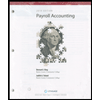
EBK CORPORATE FINANCE
4th Edition
ISBN: 9780134202785
Author: DeMarzo
Publisher: VST
expand_more
expand_more
format_list_bulleted
Question
Chapter 29.5, Problem 1CC
Summary Introduction
To discuss: The requirement of the Sarbanes–Oxley Act of 2002.
Introduction:
Sarbanes–Oxley Act is an act that was enacted in the year 2002 by Country U’s congress mainly to avoid the occurrence of misconduct. Its main aim is to protect the investors from the corporate abuse.
Expert Solution & Answer
Want to see the full answer?
Check out a sample textbook solution
Students have asked these similar questions
Crenshaw, Incorporated, is considering the purchase of a $367,000 computer with an economic life of five years. The computer will be
fully depreciated over five years using the straight-line method. The market value of the computer will be $67,000 in five years. The
computer will replace five office employees whose combined annual salaries are $112,000. The machine will also immediately lower
the firm's required net working capital by $87,000. This amount of net working capital will need to be replaced once the machine is
sold. The corporate tax rate is 22 percent. The appropriate discount rate is 15 percent. Calculate the NPV of this project.
Note: Do not round intermediate calculations and round your answer to 2 decimal places, e.g., 32.16.
NPV
Answer is complete but not entirely correct.
S 103,141.80
Your firm is contemplating the purchase of a new $610,000 computer-based order entry system. The system will be depreciated
straight-line to zero over its five-year life. It will be worth $66,000 at the end of that time. You will save $240,000 before taxes per year
in order processing costs, and you will be able to reduce working capital by $81,000 (this is a one-time reduction). If the tax rate is 21
percent, what is the IRR for this project?
Note: Do not round intermediate calculations and enter your answer as a percent rounded to 2 decimal places, e.g., 32.16.
IRR
%
QUESTION 1
Examine the information provided below and answer the following question.
(10 MARKS)
The hockey stick model of start-up financing, illustrated by the diagram below, has received a lot of attention in the
entrepreneurial finance literature (Cumming & Johan, 2013; Kaplan & Strömberg, 2014; Gompers & Lerner, 2020). The model
is often used to describe the typical funding and growth trajectory of many startups. The model emphasizes three main
stages, each of which reflects a different phase of growth, risk, and funding expectations.
Entrepreneur, 3 F's
Debt(banks & microfinance)
Research Business angels/Angel Venture funds/Venture capitalists
Merger, Acquisition
Grants
investors
PO
Public market
Growth (revenue)
Break even
point
Pide
1st round
Expansion
2nd round
3rd round
Research
commercial idea
Pre-seed
Initial concept
Seed
Early
Expansion
Financial stage
Late
IPO
Inception and
prototype
Figure 1. The hockey stick model of start-up financing (Lasrado & Lugmayr, 2013)
REQUIRED:…
Chapter 29 Solutions
EBK CORPORATE FINANCE
Ch. 29.1 - Prob. 1CCCh. 29.1 - Prob. 2CCCh. 29.2 - Prob. 1CCCh. 29.2 - Prob. 2CCCh. 29.3 - What is the main reason for tying managers...Ch. 29.3 - Prob. 2CCCh. 29.4 - Prob. 1CCCh. 29.4 - Prob. 2CCCh. 29.5 - Prob. 1CCCh. 29.5 - Prob. 2CC
Ch. 29.5 - Prob. 3CCCh. 29.6 - Prob. 1CCCh. 29.6 - Prob. 2CCCh. 29 - Prob. 1PCh. 29 - Prob. 2PCh. 29 - Prob. 3PCh. 29 - Prob. 4PCh. 29 - Prob. 5PCh. 29 - Prob. 6PCh. 29 - Prob. 7PCh. 29 - Prob. 8PCh. 29 - Prob. 9PCh. 29 - Prob. 10PCh. 29 - Prob. 11PCh. 29 - Prob. 12PCh. 29 - Prob. 13PCh. 29 - Prob. 14PCh. 29 - Prob. 15PCh. 29 - Prob. 16PCh. 29 - Prob. 17PCh. 29 - Prob. 18PCh. 29 - Prob. 19PCh. 29 - Prob. 20P
Knowledge Booster
Similar questions
- critically discuss the hockey stick model of a start-up financing. In your response, explain the model and discibe its three main stages, highlighting the key characteristics of each stage in terms of growth, risk, and funding expectations.arrow_forwardSolve this problem please .arrow_forwardSolve this finance question.arrow_forward
- solve this question.Pat and Chris have identical interest-bearing bank accounts that pay them $15 interest per year. Pat leaves the $15 in the account each year, while Chris takes the $15 home to a jar and never spends any of it. After five years, who has more money?arrow_forwardWhat is corporate finance? explain all thingsarrow_forwardSolve this finance problem.arrow_forward
arrow_back_ios
SEE MORE QUESTIONS
arrow_forward_ios
Recommended textbooks for you

 Auditing: A Risk Based-Approach to Conducting a Q...AccountingISBN:9781305080577Author:Karla M Johnstone, Audrey A. Gramling, Larry E. RittenbergPublisher:South-Western College Pub
Auditing: A Risk Based-Approach to Conducting a Q...AccountingISBN:9781305080577Author:Karla M Johnstone, Audrey A. Gramling, Larry E. RittenbergPublisher:South-Western College Pub Auditing: A Risk Based-Approach (MindTap Course L...AccountingISBN:9781337619455Author:Karla M Johnstone, Audrey A. Gramling, Larry E. RittenbergPublisher:Cengage LearningBusiness Its Legal Ethical & Global EnvironmentAccountingISBN:9781305224414Author:JENNINGSPublisher:Cengage
Auditing: A Risk Based-Approach (MindTap Course L...AccountingISBN:9781337619455Author:Karla M Johnstone, Audrey A. Gramling, Larry E. RittenbergPublisher:Cengage LearningBusiness Its Legal Ethical & Global EnvironmentAccountingISBN:9781305224414Author:JENNINGSPublisher:Cengage




Auditing: A Risk Based-Approach to Conducting a Q...
Accounting
ISBN:9781305080577
Author:Karla M Johnstone, Audrey A. Gramling, Larry E. Rittenberg
Publisher:South-Western College Pub

Auditing: A Risk Based-Approach (MindTap Course L...
Accounting
ISBN:9781337619455
Author:Karla M Johnstone, Audrey A. Gramling, Larry E. Rittenberg
Publisher:Cengage Learning

Business Its Legal Ethical & Global Environment
Accounting
ISBN:9781305224414
Author:JENNINGS
Publisher:Cengage